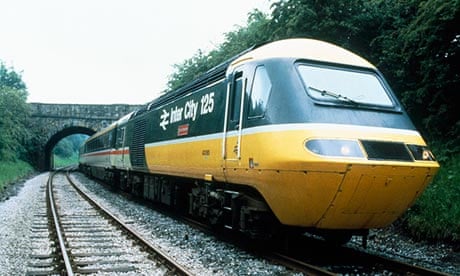Kenneth Grange, designer
In the 1970s, British Rail was on a quest for high-speed travel. The experimental Advanced Passenger Train project was supposed to deliver a vehicle that could reach 150mph by tilting round corners. However, there'd been some high-profile embarrassments when it didn't start – it wouldn't get out of the bloody station! So an alternative was brought in: a high-speed diesel.
I wasn't a rail person. I'd designed the Kenwood Chef and the Kodak Instamatic camera and was brought in to do a paint job: to put the BR livery on the engine. In those days, locomotives were big, ugly, blunt-nosed things, and the impact of what was basically a wall of steel entering a tunnel was damaging the brickwork. So without telling anyone, I decided to redesign it.
The idea to give it a streamlined front came from racing cars, which were elegantly designed. It was more a question of what I thought would go fast rather than what I knew, but I worked with an aerodynamic engineer, we built a model and tested it in a wind tunnel. The photographs looked convincing, and the board listened.
There had been several unreported incidents of driver fatalities from front windows being smashed – boys would tie string round a brick and hang it off a bridge. So my design had to allow for armoured glass. I first put in a small window through which one driver could see all he needed, but when the prototype set a world record for a diesel engine [143.2mph in May 1973], the unions insisted on there being two men in the cab sitting side by side at anything above 100mph. At first, we were going to have to use two pieces of flat glass angled towards a central bar, but then Pilkingtons developed a bigger single piece: not only was this better for visibility and aerodynamically, it gave the train that distinctive look.
The InterCity 125 was made of very robust moulded plastic, not sheet metal. This was groundbreaking. Also, with conventional trains, coaches were pulled or pushed by a locomotive – but our train would have a power car at each end, a clever piece of engineering. One day, I asked the chief engineer: "What do the buffers do?" He pointed out that because our engine car would never be pushing anything, it didn't need them. So we took them off, and that became part of the iconic look. The distinctive yellow nose was to warn people working on the track that this bloody great thing was coming.
Next came the seats, which had to be lighter for more speed. I wanted to use a sort of mesh netting, but in those days football hooligans used to take over trains and cut up the upholstery with Stanley knives. So I used strong material and moulded armrests, which has been the convention ever since. In those days, carriage doors opened via a handle on the inside, but some silly buggers had leaned against them and managed to fall out, so the InterCity used central locking.
There was a bit of a fanfare for the launch in 1977, though nothing like what would happen today. BR chairman Sir Peter Parker hired Peter Marsh, a right character, who did a legendary pitch: he kept the client waiting for an hour outside his office while he and his staff stubbed out cigarettes and made a right mess. Then he said: "This is what people think British Rail is like. It's my job to change that." His company created great slogans: "This is the age of the train" and "Let the train take the strain."
I'm 84 now and the design will see me out. I live in Devon, and the train connects me and London. When I see one, the old chest puffs up with pride.
Prue Leith, British Rail board
Sir Peter Parker was an amazing man. He spoke Japanese, was an expert on William Blake, could draw and paint, used to be an actor and once stood as a Labour candidate. He would shake anybody's hand and really listen to them. He knew me and my restaurant business very well and wanted a woman on the BR board.
Peter had become chairman when BR was the butt of jokes. When we started the "This is the age of the train" campaign, everybody said: "Yes – 45 years old." He wanted to transform the spirit and image of the railways. What happened with Jimmy Savile later is horrific, but the ad campaign featuring him worked really well.
Peter wanted me to rescue the image of the BR sandwich. I remember asking one manager: "Why do we only serve cheese sandwiches?" He told me it was Britain's most popular sandwich. I said: "Well, look at how many stations and cafes we've got, and it's the only sandwich we sell. Of course, it's Britain's most popular sandwich!"
He countered that it was made with Britain's most popular ingredients: Mother's Pride bread, Anchor butter and Kraft cheese slices. So we did a test. In the sandwich unit, I made sandwiches with wholemeal bread and fillings like salami and tomato, giving them away at Paddington station. I was terrified that the white cheese sandwich would be the most popular, but everyone went for the smoked salmon or the ploughman's.
It was often said that the British Rail sandwich was curly. It wasn't. It was soggy and sweaty – because it came wrapped in 1960s clingfilm. We put them in boxes. Suddenly you could be travelling at 125mph on this fantastically designed train – and have a decent meal. It was wonderful.

Comments (…)
Sign in or create your Guardian account to join the discussion